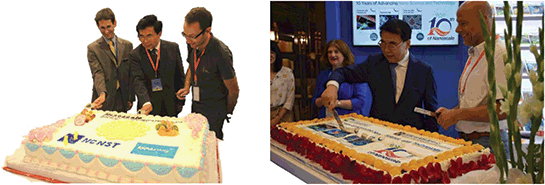Celebrating 10 years of Nanoscale
Markus
Niederberger
 a,
Francesco
Stellacci
b,
Chunli
Bai
c and
Dirk M.
Guldi
d
a,
Francesco
Stellacci
b,
Chunli
Bai
c and
Dirk M.
Guldi
d
aLaboratory for Multifunctional Materials, Department of Materials, ETH Zurich, Vladimir-Prelog-Weg 5, 8093, Zurich, Switzerland. E-mail: markus.niederberger@mat.ethz.ch
bInstitute of Materials and Interfaculty Bioengineering Institute, Ecole Polytechnique Fédérale de Lausanne (EPFL), 1015 Lausanne, Switzerland. E-mail: francesco.stellacci@epfl.ch
cNational Center for Nanoscience and Technology (NCNST), No. 11 ZhongGuanCun BeiYiTiao, 100190 Beijing, P.R. China. E-mail: clbai@cas.cn
dDepartment of Chemistry and Pharmacy and Interdisciplinary Center for Molecular Materials, Friedrich Alexander University of Erlangen-Nürnberg, Germany. E-mail: dirk.guldi@fau.de
As a collaborative venture between the Royal Society of Chemistry and the National Center for Nanoscience and Technology (NCNST) in Beijing, China, Nanoscale started with three editors in October 2009: Chunli Bai as Editor-in-Chief for Asia-Pacific, Markus Niederberger for Europe and Francesco Stellacci for the Americas. From the very beginning we received immense support from authors, so much so that in September 2009 the first issue was published with contributions from the most eminent scientists in the field of nanoscience, including work from Sir Fraser Stoddart, C. N. R. Rao, Markus Antonietti, Kazunari Domen, Naomi Halas and Luis Liz-Marzan, just to mention a few. This first issue was duly celebrated with cutting the Nanoscale cake at the launch reception during ChinaNano in Beijing.
10 years later, Nanoscale has grown immensely in the number of submitted and published papers, while keeping the highest level of quality in terms of impact and innovation. With Nanoscale Horizons and Nanoscale Advances, the nanoscale family received two new members, indicating that nanoscience hasn't lost any of its fascination and that scientists all over the world keep publishing amazing research in this field. This is beautifully exemplified in this 10th anniversary issue of Nanoscale. Ranging from the controlled synthesis of nanomaterials, and their applications in medical and energy-related fields, sensing and catalysis, to their modelling, characterization and assembly, the entire spectrum of nanoscale research is covered in this issue.
Starting 10 years ago with the intention to “showcase important and high quality nano-research, providing a forum that will be essential reading for all the scientific communities working at the nanoscale,” this goal has clearly been reached and we will do everything in our power to continue to provide the best service to the scientific community. The problems of humankind have hardly ever been as worrying as they are now. This makes research efforts and platforms that disseminate scientific results efficiently and trustworthily all the more important.
With our best wishes,
Markus Niederberger, Francesco Stellacci, Chunli Bai, Dirk M. Guldi, Founding and Current Editors-in-chief
Michaela Mühlberg, Managing Editor
| This journal is © The Royal Society of Chemistry 2019 |

